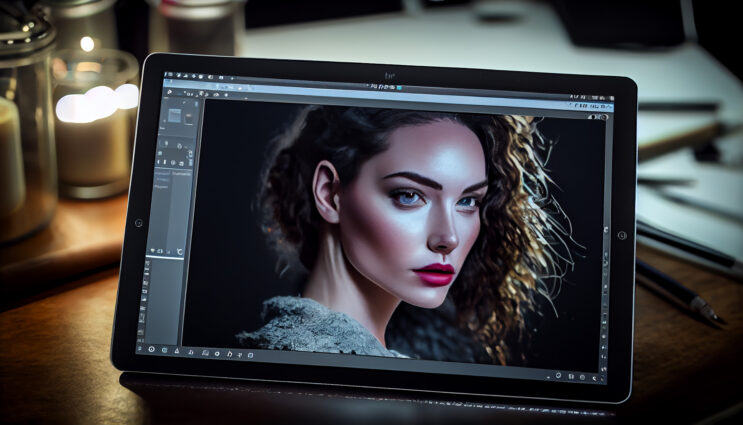If you’ve spent any time in the creative world lately, you’ve probably heard the buzz around Photoshop AI — Adobe’s mind-blowing leap into artificial intelligence. And honestly? It’s a total game changer for designers in America.
Whether you’re retouching product photos, creating social media ads, or compositing cinematic posters, Photoshop AI isn’t just another upgrade. It’s reshaping how U.S. creatives work, think, and deliver results.
From automating the boring stuff to giving small freelancers the same tools as big studios, AI in Photoshop is making creativity faster, smarter, and more profitable than ever before.
Let’s dive deep into what’s really happening — how AI is transforming the U.S. design industry, the stories of real designers adapting to it, and what the future looks like for creative work in an AI-powered America.
The Rise of AI in U.S. Creative Industries
Let’s start with the bigger picture.
The creative world in America is changing at a speed we’ve never seen before.
AI used to sound like science fiction — something that might replace factory jobs or automate customer support. But today, it’s inside our creative tools, shaping art, design, photography, and advertising in ways that no one predicted ten years ago.
Adobe jumped into the race early with its Firefly AI engine, which powers new Photoshop tools like Generative Fill, Generative Expand, and Text-to-Image features. These aren’t gimmicks — they’re powerful, production-ready tools that can turn a quick idea into a finished design in seconds.
Here’s the wild part: what used to take hours in Photoshop — background removal, object replacement, or image expansion — now takes seconds. And the output looks shockingly professional.
But this rise of AI isn’t just about faster work. It’s about democratization.
In the past, you needed years of Photoshop experience to produce magazine-level edits. Now, thanks to AI-powered guidance, anyone with a creative spark can jump in and produce pro-grade visuals. That’s a huge shift in the U.S. design landscape — where competition, freelance work, and visual marketing dominate.
In 2025, the U.S. Bureau of Labor Statistics even noted that design professionals using AI-powered tools are growing 22% faster in earnings potential compared to traditional designers.
Simply put: AI isn’t taking design jobs away; it’s giving designers superpowers.
Real Stories: How American Designers Use Photoshop AI
It’s easy to get lost in the hype — but let’s talk about how real U.S. designers are actually using Photoshop AI every day.
The Social Media Designer
Meet Kayla, a freelance social media designer from Austin, Texas. She used to spend hours editing product photos for small brands. Now, with Generative Fill, she can instantly remove messy backgrounds, extend canvases for Instagram Reels, or create realistic reflections — all with a few words of text prompt.
She told me, “What used to take 45 minutes, I now finish in five. I can take on more clients without burnout. Photoshop AI literally doubled my income.”
The Photographer-Turned-Retoucher
Then there’s Eli, a wedding photographer in New York City. Instead of outsourcing photo retouching, he uses Photoshop’s AI-powered object selection and skin retouch tools to batch-edit hundreds of portraits.
He saves about 10 hours a week and no longer needs to hire an assistant for basic edits. The result? Lower costs and more creative control.
The Agency Creative Director
Finally, Amanda, a creative director at a Los Angeles ad agency, uses Generative Expand to instantly resize hero images for multiple ad formats — from YouTube banners to Facebook carousels.
She says, “Our designers used to spend late nights just resizing stuff. Now we use AI for the repetitive work, and the team focuses on the campaign concept. Productivity skyrocketed.”
These real-world stories highlight the same theme: Photoshop AI isn’t replacing creativity — it’s freeing it.
It removes friction, eliminates busywork, and lets American designers focus on what really matters — storytelling, emotion, and impact.
Automation vs. Creativity — Striking the Right Balance
Of course, whenever AI comes up, there’s always that one question floating in every designer’s head:
“Is AI going to replace me?”
Let’s be real — no AI can replicate human emotion, cultural understanding, or creative intuition. It can generate, but it can’t truly feel.
The challenge for U.S. designers isn’t to fight automation but to learn how to work with it.
The New Creative Mindset
Designers today aren’t just artists — they’re creative directors of machine-assisted imagination. The ones thriving right now are those who treat Photoshop AI like a collaborator, not a competitor.
You tell AI what you want, but you guide it with taste, experience, and emotion. It’s like being a creative conductor — you lead, the AI plays along.
AI can make a thousand versions of a design, but only a human knows which one tells the right story.
Efficiency Without Losing Soul
Automation saves time, but creativity gives meaning.
The best designers find balance: let AI handle the time-consuming steps, and use that extra time to refine concepts, test ideas, and push boundaries.
Think about it — if AI cuts your editing time in half, that’s not a threat. That’s more time for you to grow your brand, pitch bigger clients, or explore new artistic styles.
So yes, AI is transforming creativity — but it’s doing it by removing the barriers, not by erasing the artist.
How AI Is Leveling the Playing Field for Freelancers
Now, let’s talk about something close to every American creative’s heart: freelance freedom.
For years, big agencies had all the power. They had better software, expensive retouching teams, and faster workflows. Freelancers often struggled to compete — even if they were more talented.
Photoshop AI is flipping that entire system upside down.
The Rise of the One-Person Studio
Today, a solo designer in Kansas can produce campaign-quality visuals from their laptop — no massive team, no expensive software stack, no 12-hour editing nights.
With Firefly AI’s capabilities like text-to-image generation, a freelancer can brainstorm, mock up, and deliver creative ideas at the same speed as a New York agency.
And because the AI handles tedious tasks — object removal, image extension, lighting correction — freelancers can focus on client relationships and strategic creativity.
Expanding the Client Pool
AI also allows freelancers to expand their offerings. A web designer can now offer product photography editing. A motion graphic artist can generate custom textures or backgrounds.
It’s about versatility. American freelancers who learn AI tools are transforming from specialists into multi-skilled creative entrepreneurs.
And clients love that. They don’t want “just a designer.” They want someone who can think fast, produce fast, and still deliver aesthetic quality.
That’s why you’ll notice freelance platforms like Upwork and Fiverr are flooded with new gigs titled “AI Photoshop Editor” or “AI-Enhanced Designer.”
These freelancers aren’t cheaper — they’re smarter. They use AI to increase value and output without sacrificing originality.
The Future of Design Work in an AI-Driven Market
So where does this all lead? What’s the future of design work in America when AI is integrated into every tool, workflow, and app?
The short answer: AI won’t replace designers — but designers who use AI will replace those who don’t.
Let’s look at a few future trends that every U.S. creative should keep an eye on.
1. Hybrid Workflows
Design studios across Los Angeles, New York, and Chicago are moving to hybrid creative models — part human, part AI.
Photoshop AI is becoming the “assistant” that prepares, cleans, and tests visual concepts before the human team refines the final look.
Think of it as a pre-production tool. It does the heavy lifting so humans can do the heavy thinking.
2. Subscription and Collaboration Tools
With Adobe integrating AI into its Creative Cloud ecosystem, expect tighter collaboration tools. You’ll see teams co-editing AI-generated assets, syncing styles, and managing prompts in real-time through Adobe Firefly Web, Behance, and Creative Cloud Libraries.
AI won’t just live in Photoshop — it’ll connect Illustrator, Premiere Pro, and After Effects together, creating seamless cross-software design experiences.
3. The New Skill Economy
In America’s creative job market, recruiters are already adding “AI skills” to job descriptions.
A “Photoshop Designer” job listing today often includes requirements like “familiarity with AI-assisted editing tools” or “experience with generative fill workflows.”
That means learning Photoshop AI isn’t optional anymore — it’s part of staying relevant.
And it’s not just about knowing which button to press. It’s about mastering prompting, understanding visual storytelling, and blending data with creativity.
4. Ethical Design & Authenticity
One hot debate in the U.S. design world is authenticity. If AI can generate images that look human-made, where do we draw the line between creation and manipulation?
American brands are becoming more transparent about AI usage. Some even include AI disclaimers in campaigns or use AI-generated visuals purely for concept mockups rather than final ads.
Ethical design is the next big discussion. AI will push creatives to think not just about what they can make, but what they should make.
5. Personalized Visual Marketing
With AI helping to produce visuals at scale, the next phase is personalized design — where brands can instantly tailor ad visuals to every audience segment.
Imagine a single Photoshop file that adapts its visuals based on user data — changing backgrounds, colors, or models based on viewer location or interests.
That’s not far-fetched. With AI-driven automation, it’s already happening in U.S. digital marketing agencies.
Designers who understand this level of personalization will dominate future campaigns.
Expert Tip: The AI Designer’s Mindset
If you want to thrive in this AI-driven era, you’ve got to shift how you see your tools.
Stop thinking of Photoshop as a static program. Think of it as an intelligent creative partner.
Your role is to give it vision, direction, and emotional logic. The AI can make it real — but you define the soul behind the pixels.
Keep experimenting. Try new Firefly prompts, test generative fills, explore hybrid workflows. The more you explore, the faster you’ll find your unique “AI design style.”
Why U.S. Designers Should Care Right Now
Because the market is moving fast.
Clients now expect faster turnarounds, more concepts, and better visual quality — without raising budgets.
If you don’t use Photoshop AI, someone else will — and they’ll deliver quicker, cheaper, and more polished results.
But if you do master it? You’ll stand out. You’ll save time, scale your business, and open creative doors you didn’t even know existed.
Photoshop AI isn’t about replacing human creativity. It’s about amplifying it — giving American designers the tools to dream bigger, create faster, and compete globally.
Final Thoughts
The world of design in America is evolving — fast. And Photoshop AI is leading that evolution.
It’s not just a tool; it’s a turning point.
It’s changing how designers learn, how agencies work, and how clients think about creativity.
So whether you’re a freelancer in Miami, a brand designer in Seattle, or a student in Chicago, remember this:
AI won’t make you less human — it’ll make your creativity more powerful than ever.
The future belongs to those who design with AI, not against it.
Welcome to the new creative era — the AI-powered Photoshop generation.
 Download Free Assets
Download Free Assets